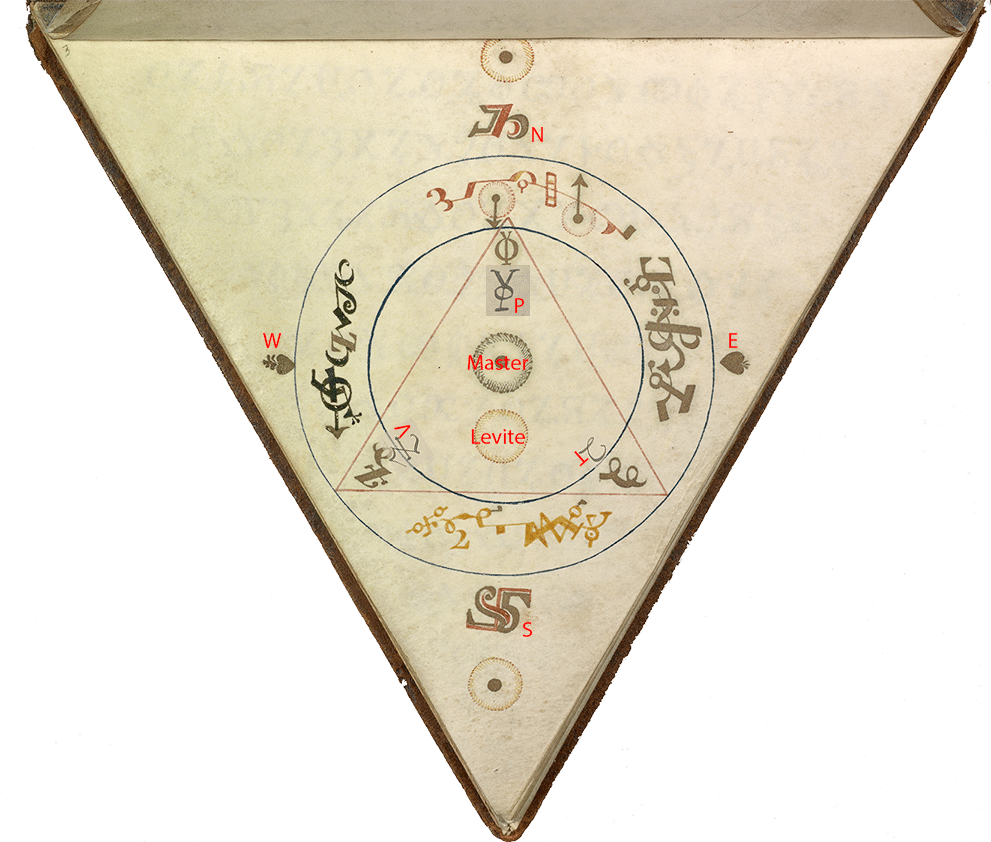The Circle, part two
Let us return to the Circle, also known as the Ritual Figure in the Triangular manuscript:

As mentioned earlier, we have an arrangement for a figure meant to be drawn on the ground during the ritual. But is there more to it?
The shape is that of the Philosophers’ Stone itself, a triangle within concentric circles. The top of the triangle is clipped, resembling The Great Pyramid, and the station of the operator is in the place of the King’s Chamber, entered through the North, just as in the actual pyramid.
The seals at the cardinal points hint at the seven classical planets and metals: the Sun and Mars at the top in red, the Moon on the left in green, Venus and Mercury in yellow at the bottom, and Saturn in black to the right. Letters resembling the mythical AZOTH peek around the perimeter.
Base points of the triangle contain cipher letters corresponding to V (left) and T (right), while P appears at the top. P is 16th, T is 20th, and V is 22nd letter of the French alphabet. Depending on order and starting point we get a combination PTV, PVT, TVP, TPV, VPT, VTP.
The following page of the manuscript states:
The circle that you see on the previous page will serve as a model to create others, which you will make nine cubits wide.
The cubit as a standard unit of measure may mean a number of different measurements, depending on how one defines a cubit. The term appears in the Bible as a unit of measure that could in some theoretical way relate the proportions of the human body to those of the celestial tabernacle and the temple of Solomon. The Biblical cubit is a standard of measurement which is precise, universal, and divine, but especially tailored to the height and reach of humans. The exact size of a cubit is unknown, but the consensus of speculations estimates it at roughly that of the human elbow to fingertip. A more common measurement for the diameter of magic circles is nine feet across, and the use of the term cubit here is to indicate the number nine as 3x3 or three squared, so that the symbol of the Stone of the Wise has its central square, without a specific demand for an established size. Like other aspects of the ritual, the ratio is more important than the absolute.
Of this circle, the author states:
You will use it to perform wonders, obtain favor that was not granted to your predecessors Berossus and Sanchuniathon.
To perform wonders is to use this work in some way that will have an impact, immediate or eventual, through which something wonderful is made to occur. It is not a work of faith, not a prayer or supplication, but one in which there is an expectation of genuine effect, something at which one might marvel but not ignore or disbelieve. It is intended to accomplish something real, and wonderful, not something purely imaginary or spiritual in character. Those who claim otherwise, citing nonsense such as “internal alchemy” or “psychological change,” err and deviate from the intended purpose.
Berossus and Sanchuniathon are both ancient writers who spoke of the history of their respective empires. They had privileged access to the important ideas and events in their world and wrote of the ways in which society had come together. Berossus wrote on people and places known to him, as a contemporary witness well educated in the ways of his people. Sanchuniathon knew the teachings and craft of the priests and the mysteries of their temples. Western culture rose from these ideas and customs many thousands of years ago.
To obtain favor not granted to these two authors, whose work exists only in fragmentary second-hand sources, is to be granted respect and acclaim as a sage and a wizard, a powerful force within the wider culture, earned through wisdom and the performance of wonders.
It will also give you the full understanding of that which is written in my revelation
— says the author. This small note has considerable meaning, suggesting that the Ritual Figure may be part of a system whereby the ciphers and puzzle within the manuscript can be rendered into comprehensible messages. Further, it clearly identifies the author as the origin of these instructions, rather than compiler or interpreter.